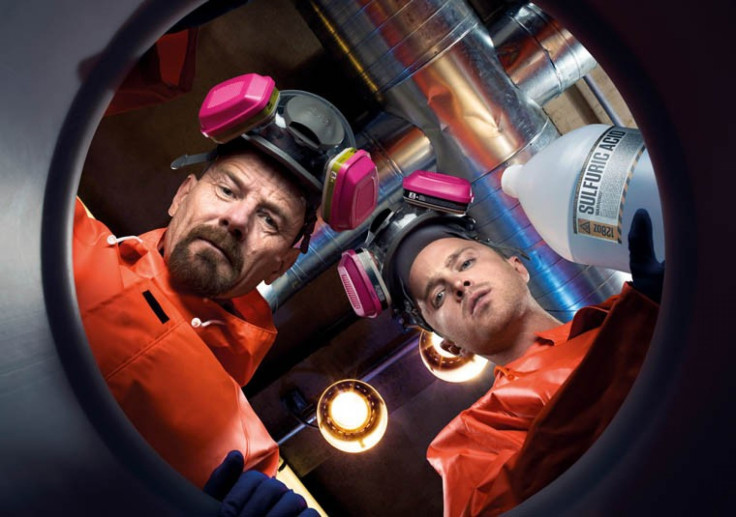'Breaking Bad' Chemistry: The Truth Behind Blue Meth And Walter White's Process

When “Breaking Bad” finally ends this weekend, viewers will bid farewell to one of the great recent TV dramas -- and a surprisingly scientifically accurate drama, at that.
It’s a rare American television series that bandies about words like “alkynes,” “diolefins” or “trienes” in its dialogue. To keep all the nomenclature straight, the writers of “Breaking Bad” rely on University of Oklahoma chemist Donna Nelson, the show’s science adviser.
“I think that much of the science is so spectacular that to me it seemed to almost become a separate character in the show,” Nelson told NPR in 2011.
The meth manufacturing processes shown onscreen are largely accurate, Nelson says -- though there's always key steps left out, so viewers won't be able to recreate Walt's product in their kitchens just from watching the show. However, not every single detail in the show is strictly true to life. The more obvious departure from reality is Walter White’s “hyper-pure” strain of methamphetamine, which comes in a characteristic blue hue. In reality, an extra-pure strain of meth would likely be either clear or yellow-tinged.
“I don’t think that’s realistic,” Nelson told Salon. “But it’s part of artistic license that we must allow creative artists to have. I think it was just meant to be Walt’s trademark.”
There is colored meth out in the real world; a veritable rainbow of it, in fact. University of California San Diego researchers examined a sample of 613 drug users in Tijuana, Medico and found people using many different shades, including clear, white, yellow, and pink. In a 2008 paper for the American Journal of Addiction, the team found that users of colored meth were more likely to experience skin abscesses than those who injected clear meth, possibly related to some added chemical in the colored versions.
Blue meth has popped up on the street in the U.S. occasionally. In July 2010, then-Kansas City Police Chief James Corwin wrote on his blog that his officers had recovered blue meth at least four times in three weeks. The blue meth the KCPD found was no more potent than clear meth. Corwin said some of his officers speculated that manufacturers were coloring their meth to try and beat a police field test, which uses a reagent that turns blue in the presence of meth. Though it’s also possible that meth makers were paying homage to “Breaking Bad,” Corwin wrote.
One turning point in the show comes when Walt decides to switch to a new recipe for meth. Their previous method required large amounts of pseudoephedrine, which is found in decongestants like Sudafed. Ever since drug stores put tighter restrictions on pseudoephedrine-containing decongestants, it’s been harder -- both on TV and in the real world -- for drug manufacturers to get it. So Walt decides to go to a new formula that requires a new base ingredient: methylamine.
Walt and Jesse go to a lot of trouble to steal barrels of methylamine, but some viewers, including Slate writer Daniel Lametti, wondered if he couldn’t just make this precursor himself, using methanol and ammonia. Lametti proposed a method that works by bubbling gaseous ammonia through methanol laced with silica gel, a dehydrating agent. The process should swap one of the hydrogen atoms on ammonia for a methyl group -- three hydrogens and a carbon -- resulting in methylamine.
But one anonymous chemist behind the blog “Just Like Cooking” said the silica gel method just wouldn’t work: a dehydrating agent absorbs water, sure, but won’t suck the water out of an alcohol mixture. Plus, methylamine production in the chemical industry, the blogger “See Arr Oh” points out, requires a series of pressurized reactors that can reach temperatures ranging from 300-500 degrees Celsius, [572 – 932 degrees Fahrenheit].
“Although an experienced chemist could produce methylamine using different reactions in a kitchen sink, he will by no means produce enough to support a burgeoning criminal enterprise which manufactures methamphetamine at multi-kilo scale,” “See Arr Oh” wrote.
So Walt probably is better off stealing barrels of methylamine than trying to cook it up himself. However the series ends on Sunday -- with a bang or a whimper -- viewers can perhaps take comfort in that they’ve learned a little bit of chemistry along the way.
“Breaking Bad,” show advisor Nelson says, disproves “the myth that it’s impossible to get the science right and still have an interesting show.”
© Copyright IBTimes 2025. All rights reserved.





















